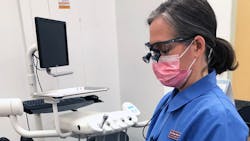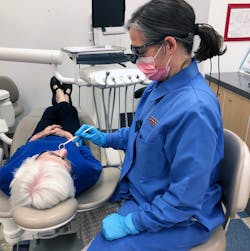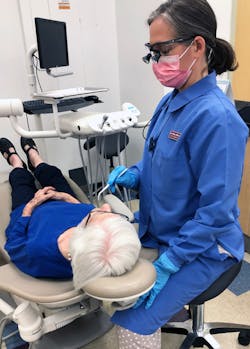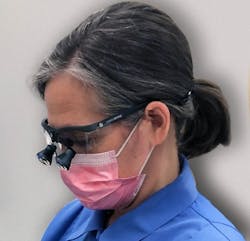From necessity to nirvana: The evolution of innovative magnification loupes
In today’s world, there is more buzz about loupes than ever. The value of magnification is now well understood by clinicians. Working with quality, custom equipment is a cornerstone for a healthy clinical career, and while the term “ergonomic” is often tossed around, it is an abused concept. A product can only be considered ergonomic if it actually assists the user to work in a safer manner. As health-care providers, it is important for dental professionals to keep up with advancements that help protect our physical health.
The clinical reality
Many clinicians are working more days, longer hours, or have longer careers than they had anticipated. These demographic changes have translated into a heightened awareness of maintaining a neutral body posture while delivering care. When loupes were first introduced, the emphasis was on improving visual acuity via an enhanced image, but now the ergonomic benefits derived from using properly fitted loupes are well understood. While it is impossible to practice without a slight forward head tilt, ergonomists recommend a posture that does not exceed more than 20 degrees from neutral. This is the reason a correct declination angle is so critical.
Treatment room designs can also have a dramatic impact on the development of neck or shoulder musculoskeletal disorders. Most dental hygienists, assistants, and many recent dental school graduates have very little say about the patient chair or their seating options. To illustrate the dynamics, think back to high school geometry for a moment. Ideally clinicians can sit in an upright position, with their elbows close to their side, and forearms parallel to the floor. All movements should remain from zero to no more than 20 degrees away from neutral. This positioning puts the least strain on the clinician’s musculoskeletal system.
The wild card
Fast forward to reality. Huge lazy-boy type patient chairs create positioning challenges. Imagine if your loupes’ declination angle was set to work with a narrow patient chair and your current office has only new wide-body patient chairs. Wide-body patient chairs increase the distance from the clinician to the patient, so your loupes declination angle may be different from your original measurement. Now what?A similar type of geometric conundrum can crop up when transitioning from traditional operator seating to a saddle stool. Saddle stools position clinicians closer to the patient and higher up. And what happens if you move to a new office where the treatment room is nothing like what you worked in for the last couple of years? Can your loupes keep up with these changes and continue to support your musculoskeletal health? The answer is yes—but first, a short review on measurements.
Declination angle details
The declination angle is the position of the ocular with respect to the loupes frame. A clinician’s declination angle is a unique, personal measurement that allows the user to view the oral cavity while keeping their head in a safe, upright posture. When set correctly, the angle minimizes forward head posture and unsafe neck flexions.The most popular loupes design is through-the-lens (TTL), in which the oculars (telescopes) are permanently mounted into the frame’s carrier lens. The fixed ocular position is based on the user’s declination angle and several other measurements including working distance and convergence point.
High quality loupes are custom-made using personal measurements based on the user’s facial geometry. Clinicians with deep-set eyes or high, prominent cheekbones require a much steeper declination angle than those with prominent eyes and/or average cheekbones.Loupes that fail to achieve the best angle
Along with facial geometry, two other factors that directly affect the declination angle are the actual loupes frame and the treatment room design. Even though high-quality loupes are custom-made, a bit of fine tuning optimizes the benefits and effectiveness. Frames with a large carrier lens from top to bottom can accommodate a steeper declination angle—a critical factor for clinicians with complex facial geometry. Frames that feature adjustable temple arms and nose pads help in the final customization. All-plastic frames are a perfect example of a frame that simply can’t be adjusted.
Multiple locations, multiple challenges
Most dental hygienists practice in multiple settings. And many new dentists also work in several locations. So, today’s clinicians frequently encounter an awkward treatment room design. Now they are facing the Goldilocks challenge—trying to minimize the stress to their bodies.
Innovation and technology
Years ago, the Orascoptic research and development teams recognized the changing demographic landscape. The question became how to create custom loupes that could accommodate different facial geometries and support potential changes in declination angles. The problem was complex and required creating an innovative new frame design that is based on solutions.
The new RDH EliteEdge loupes is not a standard eyeglass frame used to support a magnification system, but rather it is a unique frame built from the ground up to fully integrate and accommodate high-quality oculars. The frame features a lightweight metal framework covered with a durable polymer coating, and the carrier lenses are set with a steep pantoscopic tilt, a feature that enhances the declination angle.
The temple arms on the RDH EliteEdge are a unique design. The frame allows a clinician to set three different declination angles within one frame. A small screw on the inside of the temple arm is the key to adjustability. When the screw is loosened, the temple arm can be adjusted either up or down five degrees. While the steepest declination angle set at the factory is 40, the adjustability feature allows a clinician up to a 45-degree angle due to the three-position innovation.
The nose pad is also fully adjustable, allowing the user to comfortably position the frame on any nose size or shape. The nose pad can go from narrow to wide or up or down, which creates a custom distance from the eye to the frame, an important comfort feature for those with high cheek bones or long eyelashes.
The new RDH EliteEdge is crafted with a metal-reinforced frame that has flexible temple arms fabricated from spring steel covered with a dual polymer coating. The arms can be gently bent to conform to the user’s head without impinging on the user’s ears, an innovation that is both comfortable and does not distort the ocular position in the carrier lens. The RDH EliteEdge removable side shields and head strap are unique, easy-to-replace, and increase overall comfort. The frame is very lightweight at 1.5 ounces.
Materials and design: Additional features
Frame
- Two sizes – small / regular
- Durable polymer over molded metal backbone
- Temple arms spring steel – purple, blue, pink, black
- Integrated, removable side shields
- Engraved clinician name plate
Optics
- 2.5x through-the-lens
- 4.0" width of field
- 6.0" depth of field
- Oculars – antiscratch, antireflective
- Carrier lens – antireflective Trivex
Loupes package
- Clip-on head strap
- Personalized storage case
- Optical screwdriver
- Cleaning cloth
Future thoughts
Neck and shoulder pain and injuries are the two mostly common musculoskeletal disorders reported by dental hygienists. The incessant use of digital devices is further exacerbating the stress on our upper body musculature. Many consider loupes an indispensable practice tool to help counteract dangerous clinical postures. A growing number of clinicians are investing in an additional pair to ensure that they never practice a moment without this critical piece of equipment.
The real value to the new RDH EliteEdge is the ability to customize the declination to fit the situation. The RDH EliteEdge’s unique innovations will provide adaptability as one’s career evolves.
Just getting loupes is not the answer . . . getting the right loupes is the answer.Loupes saved my clinical career
Twenty-two years ago, I ordered my first pair of loupes. It was a scary purchase. I was leaving clinical practice every day exhausted and crabby and knew there had to be a better way to work. My neck and shoulders were screaming with pain, and I had no money, but I listened to my body. I ordered my first pair of loupes and paid for them on a six-month, interest-free payment plan. Within a few weeks, my shoulder, back, and neck pain was nearly gone. The physical payoff from using high quality loupes was apparent and profound.
My first loupes weighed over 50% more than today’s RDH EliteEdge. The oculars could not hold a candle to what is available now. The nose pad and temple arms were not particularly comfortable, but within a week, I knew that I would never practice again without magnification. One year later, I purchased my first headlight. I’ve never looked back. The cordless Spark headlight is my current love, and now the RDH EliteEdge is my go-to for magnification. It is the most comfortable pair of loupes that I have ever worn.
Marketing people refer to folks like me as early adopters, a badge I wear with honor, but more importantly, my clinical career would have ended decades earlier if I had not made the decision to start using loupes and a headlight. Fortunately, magnification and illumination are now mainstream and are considered the standard of care by many. And thankfully, companies such as Orascoptic are willing to invest many years and thousands of dollars in research and development to create new and innovative products that can help improve our ability to provide optimal clinical care with reduced stress to our bodies.
The science supporting adopting magnification loupes
Dangerous postural compromises
Neck and shoulder pain are well-documented among workers. A study of more than 3,000 workers found high force, high repetition, and high job demands doubled the relative risk for neck and shoulder pain.1 Women in the study were twice as likely to have neck and shoulder pain. Prolonged bending of the neck and little job control or supervisor support are also positively correlated to neck and upper limb pain.2
In an attempt to visualize the work field, dental professionals often employ awkward postures that include a forward head position (FHP) and neck flexion. FHP reduces the cervical curve and is associated with spinal compromises and decreased range of motion (ROM).3,4 Neck flexion creates a smaller craniovertebral (CV) angle, and those with a smaller CV angle have a greater forward head posture, which is positively associated with neck pain and disability.5 One study found those with carpal tunnel syndrome exhibited greater FHP and decreased cervical ROM. 4
Upper crossed syndrome (UCS) is a result of imbalances in neck, back, and chest muscles. Some muscles become weaker, while others become tighter. Workers with UCS present with FHP and neck pain as the primary symptom. The postural compromises employed by laundry workers parallel that of many dental professionals. “Individuals who present with upper crossed syndrome will show a forward head posture (FHP), hunching of the thoracic spine (rounded upper back), elevated and protracted shoulders, scapular winging, and decreased mobility of the thoracic spine. Sometimes, manual material handling activities can cause musculoskeletal disorders, for example, the workers who do their work in inappropriate position and repeating the same action throughout their workday.”6
Dental health-care worker pain
Neck, shoulder, and back pain are common among dental professionals.7-12 The prevalence is higher in female dental health-care workers11-12 and women miss more work due to back and neck pain than males.12 A recent meta-analysis of pain and musculoskeletal disorders among dental professionals reported the neck was the most affected body part,13 a finding that parallels the findings of a 2012 study of dental hygienists. 7
Magnification benefits
Studies that evaluate benefits of using magnification typically report data derived from self-administered questionnaires. Descriptive studies offer insight into a user’s perception of the value of loupes, but do not contain actual data demonstrating measurable postural changes. A small randomized trial in 2012 compared subjects fitted with magnification loupes and the control group which worked without. Neck flexion in loupes users was 2.5 times less than those without. The reduction in both head and neck flexion was statistically significant for loupes users as compared to nonusers. The authors concluded the loupes could likely reduce the risk of neck pain.14
A 12-month study of 564 dental workers divided participants into three cohorts: questionnaire only, loupes users only, and 123 who participated in both. Loupes users were individually fitted. Baseline and follow-up data were taken on those using magnification. Dental personnel who chose to wear loupes reported outcomes that were statistically significant: decreased neck pain, had fewer clinical diagnoses, lower perceived muscle exertion, and significantly improved self-rated work ability. The study concluded that wearing loupes in the clinical setting appeared to have a preventive effect on neck pain.15
Anne Nugent Guignon, MPH, RDH, CSP, provides popular programs, including topics on biofilms, power driven scaling, ergonomics, hypersensitivity, and remineralization. Recipient of the 2004 Mentor of the Year Award and the 2009 ADHA Irene Newman Award, Anne has practiced clinical dental hygiene in Houston since 1971, and can be contacted at [email protected].
References
1. Andersen JH, Kaergaard A, Frost P, Thomsen JF, Bonde JP, Fallentin N, Borg V, Mikkelsen S. Physical, psychosocial, and individual risk factors for neck/shoulder pain with pressure tenderness in the muscles among workers performing monotonous, repetitive work. Spine (Phila Pa 1976). 2002 Mar 15;27(6):660-667.
2. Sim J, Lacey RJ, Lewis M. The impact of workplace risk factors on the occurrence of neck and upper limb pain: a general population study. BMC Publ Health. 2006 Sep 19;6:234.
3. Kim DH, Kim CJ, Son SM. Neck pain in adults with forward head posture: Effects of craniovertebral angle and cervical range of motion. Osong Public Health Res Perspect. 2018 Dec;9(6):309-313. Doi: 10.24171/j.phrp.2018.9.6.04. PubMed PMID: 30584494.
4. De-la-Llave-Rincón AI, Fernández-de-las-Peñas C, Palacios-Ceña D, Cleland JA. Increased forward head posture and restricted cervical range of motion in patients with carpal tunnel syndrome. J Orthop Sports Phys Ther. 2009 Sep;39(9):658-64. Doi: 10.2519/jospt.2009.3058.
5. Yip CH, Chiu TT, Poon AT. The relationship between head posture and severity and disability of patients with neck pain. Man Ther. 2008 May;13(2):148-54. Epub 2007 Mar 23.
6. Mujawar JC, Sagar JH. Prevalence of upper cross syndrome in laundry workers. Indian J Occup Environ Med. 2019 Jan-Apr;23(1):54-56. doi: 10.4103/ijoem.IJOEM_169_18.
7. Guignon AN, Purdy CM. 2012 Dental hygiene practice in North America – The physical, economic and workforce impact of musculoskeletal disorders among clinical dental hygienists. J Dent Hyg. 2014 Oct;88(5).
8. Hayes MJ, Smith DR, Cockrell D. Prevalence and correlates of musculoskeletal disorders among Australian dental hygiene students. Int J Dent Hyg. 2009 7(3):176–181.
9. Hayes MJ, Smith DR, Cockrell D. An international review of musculoskeletal disorders in the dental hygiene profession. Int Dent J. 2010 Oct;60(5):343-52.
10. Hayes MJ, Smith DR, Taylor JA. Musculoskeletal disorders and symptom severity among Australian dental hygienists. BMC Res Notes. 2013 Jul 4;6:250.
11. Radanović B, Vučinić P, Janković T, Mahmutović E, Penjašković D. Musculoskeletal symptoms of the neck and shoulder among dental practitioners. J Back Musculoskelet Rehabil. 2017;30(4):675-679. doi: 10.3233/BMR-150508.
12. Abiodun-Solanke IM, Agbaje JO, Ajayi DM, Arotiba JT. Prevalence of neck and back pain among dentists and dental auxiliaries in South-western Nigeria. Afr J Med Med Sci. 2010 Jun;39(2):137-142.
13. Lietz J, Kozak A, Nienhaus A. Prevalence and occupational risk factors of musculoskeletal diseases and pain among dental professionals in Western countries: A systematic literature review and meta-analysis. PLoS One. 2018 Dec 18;13(12):e0208628. doi: 10.1371/journal.pone.0208628. eCollection 2018.
14. Lindegård A, Gustafsson M, Hansson GÅ. Effects of prismatic glasses including optometric correction on head and neck kinematics, perceived exertion and comfort during dental work in the oral cavity—a randomised controlled intervention. Appl Ergon. 2012 Jan;43(1):246-53. doi: 10.1016/j.apergo.2011.05.011.1
15. Lindegård A, Nordander C, Jacobsson H, Arvidsson I. Opting to wear prismatic spectacles was associated with reduced neck pain in dental personnel: longitudinal cohort study. BMC Musculoskelet Disord. 2016 Aug 17;17:347. doi:10.1186/s12891-016-1145-1.
About the Author

Anne Nugent Guignon, MPH, RDH, CSP
ANNE NUGENT GUIGNON, MPH, RDH, CSP, a visionary thinker, has received numerous accolades over four decades for mentoring, research, and guiding her profession. As an international speaker and prolific author, Anne focuses is on the oral microbiome, erosion, hypersensitivity, salivary dysfunction, ergonomics, and employee law issues. She may be contacted at [email protected].
Updated June 26, 2020




